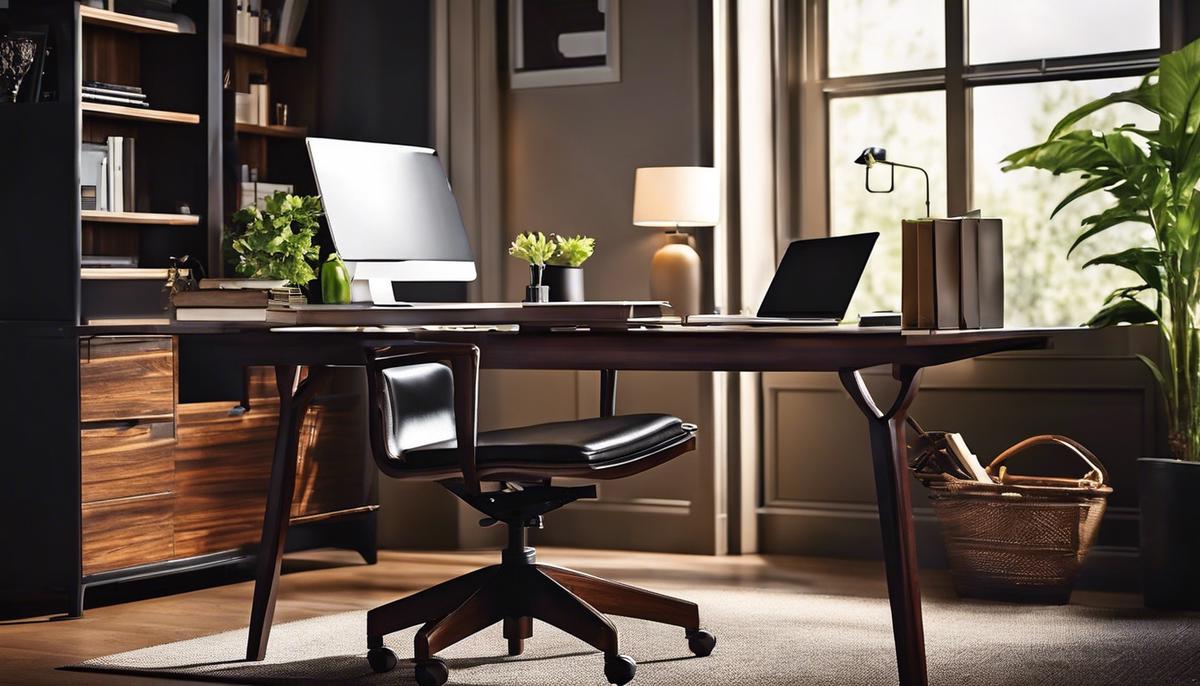The uptick in remote work has gained pace due to necessity, technological evolution, and evolving professional trends. As such, developing a sustainable work-from-home ethic is becoming increasingly vital to maintain an optimal balance between our personal and professional life. This discussion delves deep into strategies for effectively managing work boundaries while working from home. We’ll cover the importance of a conducive workspace, efficient time management, seamless communication, cohabitation considerations, and self-care routines encompassing physical and mental well-being. By implementing these strategies, remote workers can enhance productivity while simultaneously enriching their work-life balance.
Establishing a Designated Workspace
The age of the cubicle, sterile office surroundings, and water cooler chit chat are slowly being replaced by the rise of the home-based workforce. In fact, studies show that more than 56% of companies worldwide offer some capacity for remote work. With this trend, the importance of having dedicated workspaces at home has rocketed to the forefront. Let’s delve deeper into why it plays a formidable role in the modern business realm.
We often associate our environment with particular activities. Our brain, like our most loyal employee, appreciates structure and predictability. Dedicated workspaces form a clear distinction between work and leisure, fostering focus, efficiency, and productivity – key factors in the path to success.
A carefully designed workspace takes into account ergonomic fundamentals. A comfortable chair, proper desk height, appropriate lighting – these elements ward off physical stress, fatigue, and potential health issues like back problems and eye strain. Keeping these concerns at bay maintains job satisfaction, bolsters creativity, and leads to consistent output of top-class work.
Above these, a designated workspace acts as a psychological signal. It tells your mind, “It’s time to work.” Segmenting the professional from the personal reduces distractions, keeps procrastination in check, and boosts work ethic. Plus, it gives entrepreneurs an edge of professionalism while video conferencing, winning trust and respect in the competitive corporate jungle.
Moreover, a dedicated workspace is a canvas for personal branding. An entrepreneur should utilize this space to express their brand visually, not just for the outsider’s view, but to continually immerse themselves in their mission, their passion, their raison d’être. This resonates with the ethos of innovation, effecting a culture of relentless drive and ambition.
Last but not least, there’s the fiscal angle. In several jurisdictions, creating a home office allows for beneficial tax deductions. The savvy businessperson knows to make the most of such opportunities, elevating this beyond just a matter of convenience and productivity, but into financial strategy as well.
The question then shouldn’t be ‘why have a dedicated workspace at home?’, but ‘how can you afford not to?’. Your workspace is more than furnishings in a spare room. It’s a statement of professionalism, a testament to the drive, a nod to work-life balance, and overall, an investment in success. In the age of rapid business evolution, carving out a dedicated workspace at home steps forward as the smart, strategic move. It’s not just workspace, it’s works smart.

Time Management and Routine
The Power of Routines in Achieving Work-Life Balance for Remote Workers
The work revolution we faced in recent years has not just rearranged physical spaces, but has also challenged conventional workplace norms. In this ever-evolving landscape, establishing a routine can set the stage for an efficient work-life balance while working from home.
Adopting a structured routine is comparable to installing a top-notch software upgrade for your body and mind. By baking stability into our daily lives, we offer ourselves a fortified shield against chaos and stress. This, in turn, enhances productivity, reduces procrastination, and improves physical and mental well-being.
Let’s delve into the specifics of how routine-building can support remote workers in establishing a harmonious work-life balance.
Firstly, time scheduling is conjoined with maintaining a routine. With a well-structured plan, remote workers can effectively allocate their work hours, allowing for ample personal and family time. It enables us to delineate professional time from personal time, minimizing the spills from each to avoid the blurring of boundaries.
Next, routines can significantly improve productivity due to their time-bound nature. The notion of time-blocking, scheduling specific work tasks within defined time frames, can be very effective. Apart from introducing efficiency, it inhibits individuals from overworking, a common issue with remote work.
Routines also support the establishment of healthy habits. By integrating exercise, balanced meals, and self-care practices and into your schedule, you can uphold the much-needed focus and energy to conquer your professional commitments.
Moreover, routines can play a vital role in mental health. The predictability of a routine can provide a sense of security and control that is often lacking in the uncertain realm of remote work. This can significantly mitigate stress, thereby fostering better mental well-being.
Lastly, incorporating routines can influence the broader organizational culture. Companies can facilitate virtual ‘water cooler’ moments, opportunities for online social interaction, and team building. These moments create a sense of belonging, and a strong team dynamic that replicates the physical office’s environment.
Establishing a routine is not merely ticking off to-do lists. It’s about fostering productivity, cultivating healthy living habits, and nurturing mental well-being. It’s a calculated strategy to support the seamless integration of work and personal life. Remote working is here to stay, and routines are the strongest weapon in our arsenal to navigate this brave new world. Embrace the power of routines, and watch how they revolutionize the nature of your work-life balance. An investment in routine is an investment in a balanced and successful life.

Communication and Collaboration
After successfully carving a distinct work and leisure atmosphere at home, we must now delve into another pivotal element of maintaining work boundaries: effective communication and collaboration.
Communication, although often unclear like a dense fog, is the cornerstone in a remote work environment. The creation of clear, concise, and consistent communication channels reign supreme. Using the right tools is imperative. Platforms like Slack or Microsoft Teams form a virtual office, enabling real-time instant communication and reducing the typical email clutter.
Yet, such platforms need to be customized to avoid morphing into distracting social spaces. Creating focused channels, disabling non-working hour notifications, and setting clear expectations about response times can guard your work boundaries and foster efficient communication.
Another untapped source of power – asynchronous communication. The ability to manage and respond to tasks and discussions at one’s convenience instills a sense of control, reducing stress and increasing productivity.
Apart from the right tools, understanding the nuances of communication over digital platforms is essential. Power dynamics and tonality can easily be misconstrued in written communications. Cultivating mindful communication with the understanding of preserving respect and acknowledgement of others’ work boundaries can create a harmonious team dynamic.
Just as communication is an art, so is collaboration in a remote work environment; the paintbrush that adds life to the bland canvas of physical disconnect. Asynchronous and synchronous collaborations provide the flexibility needed to maintain work boundaries at home. Asynchronous collaboration, such as shared Google documents, can accommodate varying schedules. In contrast, synchronous collaborations with planned meetings and shared calendars can bolster team spirit while ensuring your work boundaries aren’t encroached upon.
In essence, the key to triumphant remote work lies not solely in constructing a defined workspace or establishing strong routines. It lies significantly in sculpting modes of communication and collaboration that honor and uphold work boundaries at home.
Here, innovation takes center stage once again, stressing the necessity to continually adapt and improve our virtual working methodologies. Thoughtful utilization of communication and collaboration tools, while respecting everyone’s work boundaries, is an essential practice we must perfect in this new era of remote work.
The art of remote working is a complex symphony. However, with the right maestro leading the charge, each instrument finds its rhythm, contributing to a harmonious balance between work and life. This inevitably leads to exciting success stories in the world of entrepreneurship, where innovation and methodical strategies shape our work environment’s future.
Remember, it is not merely about surviving in this volatile landscape, but finding opportunities to thrive and create a productive, liberating work experience. The remote work revolution has begun, and it demands levels of convenience, creativity, and tenacity we’ve never seen before. Are you ready to rise to the occasion?

Setting Boundaries with Household Members
As we progress further into the digital age, understanding and maintaining boundaries at home becomes an increasingly prevalent topic. This extends beyond just having a defined workspace or a steady routine, it’s about ensuring that those living in the same environment comprehend and respect your work structures. This can be a challenging task, but with the right techniques, it’s thoroughly achievable.
Communication is the foundation of ensuring work boundaries are respected at home. Verbally express your needs to your co-dwellers but be open-minded to their needs as well. This shared understanding creates a mutual respect that can ultimately result in a more focused and productive work atmosphere at home.
Remember, it’s not just about speaking, it’s about how it’s said. Be assertive, not aggressive. Make it clear that when you’re in your workspace, you’re engaged in work – it’s not the time for casual banter or household issues. This doesn’t mean creating an iron wall between personally and professionally, it simply means setting realistic expectations about when you are, and aren’t, available.
Creating visible indicators can also be highly effective for preserving your work boundaries. Examples could include physically closing a door or using a ‘Do Not Disturb’ sign. Be consistent with these signals, and over time they’ll become understood norms in your household, giving you the uninterrupted work time you need.
People work differently; some prefer complete silence while others can tolerate background noise or activity. Factor in your distinctive work style, as one-size-fits-all approach doesn’t pertain here. Discuss your working style with your household members and come up with solutions that cater to everyone. This might include using headphones, having quiet hours, or establishing communal areas for noise and activity.
Structure and planning can assist in reducing work-related disturbances. Use calendars, schedules, and even productivity management apps to make visible when you’re working. By being demarcated about the time you’re unavailable can lead to less accidental disruption.
Finally, exercise patience and flexibility. Just like integrating new habits, these boundaries might take time for family members and co-dwellers to get accustomed to. Likely, there will be instances where they forget or unintentionally impinge on your work routine. Instead of getting frustrated, use those instances as opportunities to gently remind them about the importance of these boundaries.
Emphasizing work boundaries at home can be a complex task, but it’s pivotal in ensuring productivity and well-being. When we manage to balance successfully, we not only improve our work quality and output, but also create a more harmonized home environment. It’s through this strategic approach that we can truly thrive in the era of remote work, bolstering both career prospects and overall life satisfaction. endeavor++

Digital Detox and Mental Health
Building on the well-laid foundation of creating a conducive home workspace, implementing disciplined routines, establishing effective communication, and setting firm work boundaries, it is now time to delve into the necessity of regular digital detoxes and incorporating mental health care into our daily routine. In this increasingly hyper-connected world, striking a healthy balance between our digital lives and our mental well-being is more paramount than ever before.
A digital detox refers to a period during which an individual refrains from using digital devices. This kind of intentional disconnect has become essential in the contemporary landscape of remote work. Continual engagement with digital platforms can lead to digital fatigue, a state of mental exhaustion that can impair productivity and generate stress. Committing to regular breaks from screens and technology can recharge one’s mental energy, leading to increased productivity, creativity, and well-being during work hours.
Incorporating mental health care into our daily routine is likewise essential. Just as we invest in ergonomic furniture for our physical comfort, we must invest in practices to promote our psychological well-being. Methods such as meditation, mindfulness, and cognitive rejuvenation exercises can be invaluable in managing stress levels and fostering a healthy mind.
While digital detoxes and mental health care might initially seem less crucial than having an efficient workstation or setting clear work-life boundaries, they are integral pillars of a successful remote work strategy. Successful entrepreneurs understand the importance of taking care of their mental health, not only for themselves but also because it influences workplace dynamics, organizational culture, and ultimately the bottom line.
Evidently, the success of remote work lies not only in material conversions of space or improving the processes we follow. It also depends on the invisible, intangible attitudes we nurture and uphold, like regular digital detoxes and genuine care for our mental health. Both are integral in maintaining boundaries and preserving our well-being in an increasingly digital work landscape. So, remember to unplug, unwind, and take a mindful moment for yourself amidst the hustle and bustle of remote work – your mind will thank you!

Working from home, while providing an array of flexibilities, still poses a unique set of challenges that need proactive management. A well-structured workspace, disciplined routine, articulate communication, and respect for privacy are fundamental aspects to navigate these challenges. But it’s equally important not to lose sight of individual well-being in pursuit of professional performance. To switch off effectively from work and engage in digital detox becomes as imperative as any other professional responsibility. With a healthy association of these principles, anyone can maintain a productive and stress-free approach to remote working, while nurturing a harmonious work-life balance.

Matt Smith is a seasoned journalist and author whose expertise spans across the dynamic realms of Politics, Gadgets, Gaming, and a plethora of general interest topics. With a Master’s in Political science and tech pedigree shaped in Silicon Valley, Matt brings a wealth of knowledge and a critical eye to everything he writes.
Politics: Matt offers sharp political commentary, drawing from his experience as a political analyst and his academic rigor.
Gadgets: His tech insights are grounded in real-world experience, having been on the front lines of innovation with a degree from Caltech.
Gaming: A respected voice in gaming, Matt’s reviews and trend analyses are a testament to his deep involvement in the gaming community.
General Topics: From science to culture, Matt’s writing spans a broad spectrum, engaging readers with a blend of expertise and relatable prose.
Engage with Matt’s compelling content for a fresh perspective on the issues at the forefront of today’s discourse.

